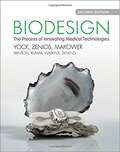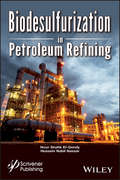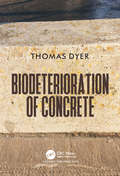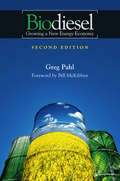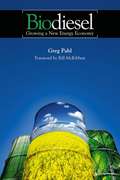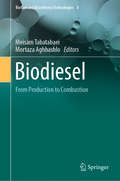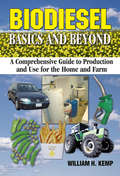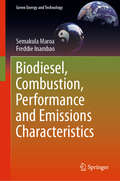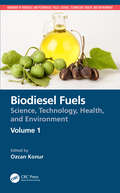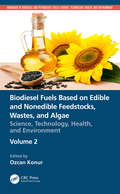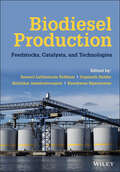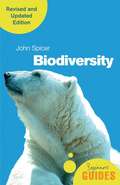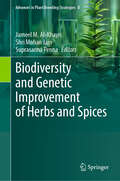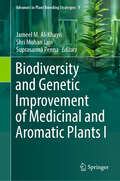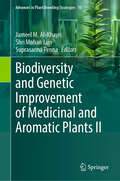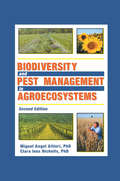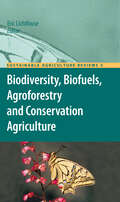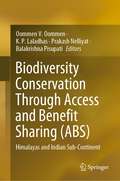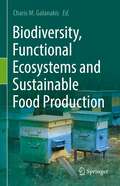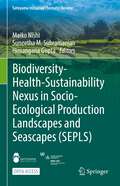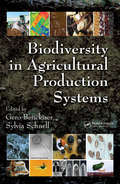- Table View
- List View
Biodesign: The Process of Innovating Medical Technologies
by Paul G. Yock Stefanos Zenios Josh Makower Todd J. Brinton Uday N. Kumar F. T. Jay Watkins Lyn Denend Thomas M. Krummel Christine Q. KuriharaThis step-by-step guide to medical technology innovation, now in full color, has been rewritten to reflect recent trends of industry globalization and value-conscious healthcare. Written by a team of medical, engineering, and business experts, the authors provide a comprehensive resource that leads students, researchers, and entrepreneurs through a proven process for the identification, invention, and implementation of new solutions. Case studies on innovative products from around the world, successes and failures, practical advice, and end-of-chapter 'Getting Started' sections encourage readers to learn from real projects and apply important lessons to their own work. A wealth of additional material supports the book, including a collection of nearly one hundred videos created for the second edition, active links to external websites, supplementary appendices, and timely updates on the companion website at ebiodesign.org. Readers can access this material quickly, easily, and at the most relevant point in the text from within the ebook.
Biodesulfurization in Petroleum Refining
by Nour Shafik El-Gendy Hussein Mohamed NassarPetroleum refining and process engineering is constantly changing. No new refineries are being built, but companies all over the world are still expanding or re-purposing huge percentages of their refineries every year, year after year. Rather than building entirely new plants, companies are spending billions of dollars in the research and development of new processes that can save time and money by being more efficient and environmentally safer. Biodesulfurization is one of those processes, and nowhere else it is covered more thoroughly or with more up-to-date research of the new advances than in this new volume from Wiley-Scrivener. <p><p> Crude oil consists of hydrocarbons, along with other minerals and trace elements. Sulfur is the most abundant element after carbon and hydrogen, then comes after it nitrogen, and they usually concentrated in the higher boiling fractions of the crude oil. The presence of sulfur compounds causes the corrosion of refining facilities and catalysts poisoning. Moreover, the presence of nitrogen-compounds directly impacts the refining processes via; poisoning the cracking catalysts and inhibiting the hydrodesulfurization catalysts. In addition, both have bad impacts on the environment, throughout the sulfur and nitrogen oxide emissions. Removing this sulfur and nitrogen from the refining process protects equipment and the environment and creates a more efficient and cost-effective process. <p> Besides the obvious benefits to biodesulfurization, there are new regulations in place within the industry with which companies will, over the next decade or longer, spend literally tens, if not hundreds, of billions of dollars to comply. Whether for the veteran engineer needing to update his or her library, the beginning engineer just learning about biodesulfurization, or even the student in a chemical engineering class, this outstanding new volume is a must-have. Especially it covers also the bioupgrading of crude oil and its fractions, biodenitrogenation technology and application of nanotechnology on both bio-desulfurization and denitrogenation technologies.
Biodeterioration of Concrete
by Thomas DyerAwareness of the importance of ensuring durability of concrete has been a growing concern of engineers, and there is now considerable understanding of the mechanisms, which cause its deterioration, and means of limiting such damage through the use of appropriate materials and approaches to design. Many of the deterioration mechanisms, which affect concrete, are the result of interaction with the non-living environment – chlorides in seawater, carbon dioxide in the atmosphere, cyclic freezing and thawing. However, living organisms can also cause damage – through both chemical and physical processes - which under the right conditions, can be severe. This book looks at all forms of concrete biodeterioration together for the first time. It examines, from a fundamental starting point, biodeterioration mechanisms, as well as the conditions which allow living organisms (bacteria, fungi, plants and a range of marine organisms) to colonise concrete. A detailed evaluation of chemical compounds produced by living organisms with respect to their interaction with the mineral constituents of concrete, and the implications it has for the integrity of structures, is also included. Approaches to avoiding biodeterioration of concrete are also covered, including selection of materials, mix proportioning, design, and use of protective systems.
Biodiesel: Assessment of Environmental Impact in Producing and Using Chains
by Armen B. Avagyan Bhaskar SinghAir pollution policy is closely connected with climate change, public health, energy, transport, trade, and agriculture, and generally speaking, the Earth has been pushed to the brink and the damage is becoming increasingly obvious. The transport sector remains a foremost source of air pollutants – a fact that has stimulated the production of biofuels. This book focuses on the biodiesel industry, and proposes a modification of the entire manufacturing chain that would pave the way for further improvements. Oil derived from oilseed plantations/crops is the most commonly used feedstock for the production of biodiesel. At the same time, the UK’s Royal Academy of Engineering and 178 scientists in the Netherlands have determined that some biofuels, such as diesel produced from food crops, have led to more emissions than those produced by fossil fuels. Accordingly, this book re-evaluates the full cycle of biodiesel production in order to help find optimal solutions. It confirms that the production and use of fertilizers for the cultivation of crop feedstocks generate considerably more GHG emissions compared to the mitigation achieved by using biodiesel. To address this fertilization challenge, projecting future biofuel development requires a scenario in which producers shift to an organic agriculture approach that includes the use of microalgae. Among advanced biofuels, algae’s advantages as a feedstock include the highest conversion of solar energy, and the ability to absorb CO2 and pollutants; as such, it is the better choice for future fuels. With regard to the question of why algae’s benefits have not been capitalized on for biofuel production, our analyses indicate that the sole main barrier to realizing algae’s biofuel potential is ineffective international and governmental policies, which create difficulties in reconciling the goals of economic development and environmental protection.
Biodiesel
by Greg PahlFor anyone who is trying to keep up with the extremely rapid developments in the biodiesel industry, the second edition of Biodiesel: Growing a New Energy Economy is an invaluable aid. The breathtaking speed with which biodiesel has gained acceptance in the marketplace in the past few years has been exceeded only by the proliferation of biodiesel production facilities around the United States-and the world-only to confront new social and environmental challenges and criticisms. The international survey of the biodiesel industry has been expanded from 40 to more than 80 countries, reflecting the spectacular growth of the industry around the world. This section also tracks the dramatic shifts in the fortunes of the industry that have taken place in some of these nations. The detailed chapters that cover the industry in the United States have also been substantially rewritten to keep abreast of its many new developments and explosive domestic growth. An expanded section on small-scale, local biodiesel production has been added to better represent this small but growing part of the industry. Another new section has been added to more fully explore the increasingly controversial issues of deforestation and food versus fuel, as well as GMO crops. The second edition concludes with updated views on where the industry is headed in the years to come from some of its key players.
Biodiesel: Growing a New Energy Economy
by Greg PahlThe potential of biodiesel to replace petroleum-based diesel (petrodiesel) fuel is not new. Farmers and alternative fuels advocates have been experimenting with and using vegetable oils to operate tractors, trucks, generators and all sorts of other engines for decades. In Europe, Pahl reports, biodiesel has been manufactured on an industrial scale since 1992 and with strong government support from the European Union it has replaced 2 percent of the petrodiesel use in member countries. The goal there is to increase that percentage to 5.75 by 2010 in order to reduce dependence on foreign oil and to cut back on greenhouse emissions.
Biodiesel: From Production to Combustion (Biofuel and Biorefinery Technologies #8)
by Meisam Tabatabaei Mortaza AghbashloThis book presents in-depth information on the state of the art of global biodiesel production and investigates its impact on climate change. Subsequently, it comprehensively discusses biodiesel production in terms of production systems (reactor technologies) as well as biodiesel purification and upgrading technologies. Moreover, the book reviews essential parameters in biodiesel production systems as well as major principles of operation, process control, and trouble-shooting in these systems. Conventional and emerging applications of biodiesel by-products with a view to further economize biodiesel production are also scrutinized. Separate chapters are dedicated to economic risk analysis and critical comparison of biodiesel production systems as well as techno-economical aspects of biodiesel plants. The book also thoroughly investigates the important aspects of biodiesel production and combustion by taking advantage of advanced sustainability analysis tools including life cycle assessment (LCA) and exergy techniques. In closing, the application of Omics technologies in biodiesel production is presented and discussed. This book is relevant to anyone with an interest in renewable, more sustainable fuel and energy solutions.
Biodiesel Basics and Beyond
by William H. KempBiodiesel Basics and Beyond aims to separate fact from fiction and to educate potential home, farm, and cooperative manufacturers on the economic production of quality biodiesel from both waste and virgin oil feedstock. The book includes: detailed processes and equipment required to produce biodiesel fuel that meets North American standards how farmers can use excess oilseed as a feedstock for biodiesel production the use of the co-byproduct glycerin in the making of soap a guide to numerous reference materials and a list of supplier data This is North America's definitive guide to responsibly producing biodiesel from waste vegetable oil while minimizing your environmental footprint in the process.
Biodiesel, Combustion, Performance and Emissions Characteristics (Green Energy and Technology)
by Semakula Maroa Freddie InambaoThis book focuses on biodiesel combustion, including biodiesel performance, emissions and control. It brings together a range of international research in combustion studies in order to offer a comprehensive resource for researchers, students and academics alike. The book begins with an introduction to biodiesel combustion, followed by a discussion of NOx formation routes. It then addresses biodiesel production processes and oil feedstocks in detail, discusses the physiochemical properties of biodiesel, and explores the benefits and drawbacks of these properties. Factors influencing the formation of emissions, including NOx emissions, are also dealt with thoroughly. Lastly, the book discusses the mechanisms of pollution and different approaches used to reduce pollutants in connection with biodiesel. Each approach is considered in detail, and diagrams are provided to illustrate the points in line with industry standard control mechanisms.
Biodiesel Fuels: Science, Technology, Health, and Environment (Handbook of Biodiesel and Petrodiesel Fuels)
by Ozcan KonurThis first volume of the Handbook of Biodiesel and Petrodiesel Fuels presents a representative sample of the population papers in the field of biodiesel fuels in general. Part I provides an overview of the research field on both biodiesel and petrodiesel fuels highlighting primary and secondary research fronts in these fields. Part II presents a representative sample of the population papers in the field of biooils covering major research fronts. The research on the biooils is a fundamental part of the research on the biodiesel fuels. The research in this field has intensified in recent years with the application of advanced catalytic technologies and nanotechnologies in both production and upgrading of biooils. It covers pyrolysis, hydrothermal liquefaction, and upgrading, and characterization and properties of biooils besides an overview of the research field. Part III presents a representative sample of the population papers in the field of biodiesel fuels in general covering major research fronts. The research in this field has progressed in the lines of production, properties, and emissions of biodiesel fuels. As in the case of biooils, catalysts and additives play a crucial role for the biodiesel fuels. It covers biomass-based catalyst-assisted biodiesel production, enzymatic biodiesel production, additives in biodiesel production, properties, characterization, performance, and policies of biodiesel fuels besides an overview of the research field. Part IV presents a representative sample of the population papers in the field of glycerol, biodiesel waste, covering major research fronts. The research in this field has intensified in recent years with the increasing volume of biodiesel fuels, creating eco-friendly solutions for these wastes of biodiesel fuels for producing valuable biofuels and biochemicals from glycerol. It covers biohydrogen and propanediol production from glycerol as a case study for bioenergy and biochemicals, respectively. This book will be useful to academics and professionals in the fields of Energy Fuels, Chemical Engineering, Physical Chemistry, Biotechnology and Applied Microbiology, Environmental Sciences, and Thermodynamics. Ozcan Konur is both a materials scientist and social scientist by training. He has published around 200 journal papers, book chapters, and conference papers. He has focused on the bioenergy and biofuels in recent years. In 2018, he edited Bioenergy and Biofuels, which brought together the work of over 30 experts in their respective field. He also edited the Handbook of Algal Science, Technology, and Medicine with a strong section on the algal biofuels in 2020.
Biodiesel Fuels Based on Edible and Nonedible Feedstocks, Wastes, and Algae: Science, Technology, Health, and Environment (Handbook of Biodiesel and Petrodiesel Fuels)
by Ozcan KonurThis second volume of the Handbook of Biodiesel and Petrodiesel Fuels presents a representative sample of the population papers in the field of feedstock-specific biodiesel fuels. The research on feedstocks for biodiesel fuels has first focused on the edible oils as first-generation biodiesel fuels. However, the public concerns about the competition with foods based on these feedstocks and adverse impact on the ecological diversity and deforestation have resulted in the exploration of nonedible-oil-based biodiesel fuels as second-generation biodiesel fuels in the first instance. Due to the ecological and cost benefits of treating wastes, waste oil-based biodiesel fuels as third-generation biodiesel fuels have emerged. Furthermore, following a series of influential review papers, the research has focused on the algal oil-based biodiesel fuels in recent years. Since the cost of feedstocks in general constitutes 85% of the total biodiesel production costs, the research focused more on improving biomass and lipid productivity in these research fields. Furthermore, since water, CO2, and nutrients (primarily N and P) have been major ingredients for the algal biomass and lipid production, the research has also intensified in the use of wastewaters and flue gases for algal biomass production to reduce the ecological burdens and the production costs. Part 1 presents a representative sample of the population papers in the field of edible oil-based biodiesel fuels covering major research fronts. It covers soybean oil-based biodiesel fuels, palm oil-based biodiesel fuels, and rapeseed oil-based biodiesel fuels as case studies besides an overview paper. Part 2 presents a representative sample of the population papers in the field of nonedible oil-based biodiesel fuels covering major research fronts. It covers Jatropha oil-based biodiesel fuels, polanga oil-based biodiesel fuels, and moringa oil-based biodiesel fuels as case studies besides an overview paper. Part 3 presents a representative sample of the population papers in the field of waste oil-based biodiesel fuels covering major research fronts. It covers wastewater sludge-based biodiesel fuels, waste cooking oil-based biodiesel fuels, and microbial oil-based biodiesel fuels as case studies besides an overview paper. Part 4 presents a representative sample of the population papers in the field of algal oil-based biodiesel fuels covering major research fronts. It covers algal biomass production in general, algal biomass production in wastewaters, algal lipid production, hydrothermal liquefaction of algal biomass, algal lipid extraction, and algal biodiesel production besides an overview paper. This book will be useful to academics and professionals in the fields of Energy Fuels, Chemical Engineering, Physical Chemistry, Biotechnology and Applied Microbiology, Environmental Sciences, and Thermodynamics. Ozcan Konur is both a materials scientist and social scientist by training. He has published around 200 journal papers, book chapters, and conference papers. He has focused on the bioenergy and biofuels in recent years. In 2018, he edited ‘Bioenergy and Biofuels’, that brought together the work of over 30 experts in their respective field. He also edited ‘Handbook of Algal Science, Technology, and Medicine’ with a strong section on the algal biofuels in 2020.
Biodiesel Production: Feedstocks, Catalysts, and Technologies
by Samuel Lalthazuala Rokhum Gopinath Halder Suttichai Assabumrungrat Kanokwan NgaosuwanAn incisive discussion of biofuel production from an economically informed technical perspective that addresses sustainability and commercialization together In Biodiesel Production: Feedstocks, Catalysts and Technologies, renowned chemists Drs Rokhum, Halder, Ngaosuwan and Assabumrungrat present an up-to-date account of the most recent developments, challenges, and trends in biodiesel production. The book addresses select feedstocks, including edible and non-edible oils, waste cooking oil, microalgae, and animal fats, and highlights their advantages and disadvantages from a variety of perspectives. It also discusses several catalysts used in each of their methods of preparation, as well as their synthesis, reactivity, recycling techniques, and stability. The contributions explore recently developed technologies for sustainable production of biodiesel and provides robust treatments of their sustainability, commercialization, and their prospects for future biodiesel production. A thorough introduction to the various catalysts used in the preparation of biodiesel and their characteristics Comprehensive explorations of biofuel production from technical and economic perspectives, with complete treatments of their sustainability and commercialization Practical discussions of the development of new strategies for sustainable and economically viable biodiesel production In-depth examinations of biodiesel feedstocks, catalysts, and technologiesPerfect for academic researchers and industrial scientists working in fields that involve biofuels, bioenergy, catalysis, and materials science, Biodiesel Production: Feedstocks, Catalysts and Technologies will also earn a place in the libraries of bioenergy regulators.
Biodiesel Production with Green Technologies
by Pogaku Ravindra Aminul IslamThis book provides a single-source reference to green technologies in advanced biofuel technology. The main focus is on the description of the state of the art in catalytic processes for the "green" production of biofuels. The authors describe two different, practical approaches for catalysts, which allow for effective and easy separation of the catalyst by simple filtration, and enable reuse for several cycles. Readers will gain understanding as to the mechanisms involved in the synthesis and structure formation of the catalyst, in order to maximize yield of biodiesel production. The authors also address the question of how catalytic material should be distributed inside a porous support to obtain optimal performance. The effects of physicochemical and operating parameters are analyzed to gain insight into the underlying phenomena governing the performance of optimally designed catalysts.
Biodiversity: A Beginner's Guide (revised and updated edition) (Beginner's Guides)
by John SpicerOur future is closely tied to that of the variety of life on Earth, and yet there is no greater threat to it than us. From population explosions and habitat destruction to climate change and mass extinctions, John Spicer explores the causes and consequences of our biodiversity crisis. In this revised and updated edition, he examines how grave the situation has become over the past decade and outlines what we must do now to protect and preserve not just nature&’s wonders but the essential services that biodiversity provides for us, seemingly for nothing.
Biodiversity and Genetic Improvement of Herbs and Spices (Advances in Plant Breeding Strategies #8)
by Jameel M. Al-Khayri Shri Mohan Jain Suprasanna PennaThe herbs and spices plants have immensely benefited humankind since ancient times for therapeutic, cosmetic, and nutritional properties. The wealth of information on genetic resources, breeding, conservation, propagation, cultivation, and biotechnological strategies is crucial for plant improvement. This volume consists of 19 chapters covering research advances in conventional and modern breeding technologies of various important herbs and spices individually, including Basil, Bay leaf, Cinnamon, Coriander, Dill, Lemongrass, Long pepper, Nutmeg, Onion, Oregano, Parsley, Pepper, Saffron, Sage, Sesame, Tarragon, Thyme, Common turmeric, and Scentless turmeric. Chapters are written by globally renowned scientists and subjected to a rigorous review process to ensure quality presentation and scientific precision. Each chapter has an introduction covering related backgrounds and provides an in-depth discussion of the subject supported with high-quality color photos, illustrations and relevant data. The chapter concludes with future research directions and pertinent references to facilitate further reading. The book is an excellent reference source for plant breeders, biotechnologists and geneticists engaged in breeding and improvement. The book is suitable for both advanced undergraduate and postgraduate students specializing in agriculture, biotechnology, and molecular breeding as well as for seed companies.
Biodiversity and Genetic Improvement of Medicinal and Aromatic Plants I (Advances in Plant Breeding Strategies #9)
by Shri Mohan Jain Jameel M. Al-Khayri Suprasanna PennaThe medicinal and aromatic plants have immensely benefited humankind since ancient times for therapeutic, cosmetic, and nutritional properties. The wealth of information on genetic resources, breeding, conservation, propagation, cultivation, and biotechnological strategies is crucial for plant improvement. This volume consists of 12 chapters covering research advances in conventional and modern breeding technologies of various medicinal and important aromatic plants individually, including Brahmi, Barberry, Betel, Blond plantain, Caper, Chinese woad, Common hop, Damask rose, Deadly, Echinacea, Ginkgo, and Gymnema. Chapters are written by globally renowned scientists and subjected to a rigorous review process to ensure quality presentation and scientific precision. Each chapter has an introduction covering related backgrounds and provides an in-depth discussion of the subject supported with high-quality color photos, illustrations and relevant data. The chapter concludes with future research directions and pertinent references to facilitate further reading. The book is an excellent reference source for plant breeders, biotechnologists and geneticists engaged in breeding and improvement. The book is suitable for both advanced undergraduate and postgraduate students specializing in agriculture, biotechnology, and molecular breeding as well as for seed companies.
Biodiversity and Genetic Improvement of Medicinal and Aromatic Plants II (Advances in Plant Breeding Strategies #10)
by Shri Mohan Jain Jameel M. Al-Khayri Suprasanna PennaThe medicinal and aromatic plants have immensely benefited humankind since ancient times for therapeutic, cosmetic, and nutritional properties. The wealth of information on genetic resources, breeding, conservation, propagation, cultivation, and biotechnological strategies is crucial for plant improvement. This volume consists of 13 chapters covering research advances in conventional and modern breeding technologies of various medicinal and important aromatic plants individually, including Indian ginseng, Datura, Licorice, Marjoram, Moringa, Neem, Opium poppy, Patchouli, Persian shallot, Plumbago, St John's-wort, Stevia, and Upastree resin. Chapters are written by globally renowned scientists and subjected to a rigorous review process to ensure quality presentation and scientific precision. Each chapter has an introduction covering related backgrounds and provides an in-depth discussion of the subject supported with high-quality color photos, illustrations and relevant data. The chapter concludes with future research directions and pertinent references to facilitate further reading. The book is an excellent reference source for plant breeders, biotechnologists and geneticists engaged in breeding and improvement. The book is suitable for both advanced undergraduate and postgraduate students specializing in agriculture, biotechnology, and molecular breeding as well as for seed companies
Biodiversity and Pest Management in Agroecosystems
by Miguel Altieri Clara NichollsExplore the latest research on biological control! Completely updated for 2004, this new edition examines methods for making agricultural systems less susceptible to insect pests. Containing new findings and reports of strategies, Biodiversity and Pest Management in Agroecosystems, Second Edition will show you how pests can be managed by enhancing beneficial biodiversity using agroecological diversification methods. Biodiversity and Pest Management in Agroecosystems, Second Edition provides you with an essential overview of the role of biodiversity in agriculture and then gets specific, with new and updated information on: the agroecology of pest management plant diversity and pest outbreaks within agroecosystems diversification strategies for pest management how sustainable farming systems are designed You'll also explore: the role of plant diversity on the biology of beneficial insects insect regulation in diverse agroecosystems manipulation of plant diversity in agroecosystems ecological and socioeconomic implications The fact is, many modern agroecosystems are unstable as a consequence of constant human intervention in crop systems which ignore ecological principles. With case studies on a variety of crops and pests, Biodiversity and Pest Management in Agroecosystems, Second Edition explores entomological aspects of agriculture and analyzes the ecological basis for the maintenance of biodiversity. It will familiarize you with the theory and practice of enhancing biological pest control in agricultural systems by managing vegetational diversity via multiple cropping, cover cropping, rotations, and other spatial and temporal designs. With studies on intercropping, cover cropping, weed management, and crop-field border vegetation manipulation, this book covers the effects of these diverse systems on pest population density and the mechanisms underlying pest reduction in polycultures. Make it a part of your reference/teaching collection today!
Biodiversity, Biofuels, Agroforestry and Conservation Agriculture (Sustainable Agriculture Reviews #5)
by Eric LichtfouseSustainable agriculture is a rapidly growing field aiming at producing food and energy in a sustainable way for our children. This discipline addresses current issues such as climate change, increasing food and fuel prices, starvation, obesity, water pollution, soil erosion, fertility loss, pest control and biodiversity depletion. Novel solutions are proposed based on integrated knowledge from agronomy, soil science, molecular biology, chemistry, toxicology, ecology, economy, philosophy and social sciences. As actual society issues are now intertwined, sustainable agriculture will bring solutions to build a safer world. This book series analyzes current agricultural issues, and proposes alternative solutions, consequently helping all scientists, decision-makers, professors, farmers and politicians wishing to build safe agriculture, energy and food systems for future generations.
Biodiversity Conservation Through Access and Benefit Sharing (ABS): Himalayas and Indian Sub-Continent
by K. P. Laladhas Oommen V. Oommen Prakash Nelliyat Balakrishna PisupatiThis book deals with the economic potentials of biodiversity and its capacity to support its own conservation aiming to provide livelihood for millions engaged in conservation, both now and for future generations. The book highlights the potentials of natural resources which are characterized as capital wealth (as defined in Convention on Biological Diversity (CBD)), to finance its own conservation and to provide livelihood means to people who conserve it.The book is divided into five Parts. PART I explains about the Premise of Access and Benefit Sharing (ABS), PART II describes about the Technology Transfer, PART III will provide details about the Access to Genetic Resources and to Associated Traditional Knowledge and Benefit Sharing PART IV is the Implementation of ABS Mechanisms and PART V is about ABS and Its Economics.This book will be of interest to biodiversity policy makers, administrators, university and college students, researchers, biodiversity conservationists.
Biodiversity, Functional Ecosystems and Sustainable Food Production
by Charis M. GalanakisIn recent decades, practices like the cultivation of a few high-yielding crop varieties on a large scale, the application of heavy machinery and continued mechanization of agriculture, the removal of natural habitats, and the application of pesticides and synthetics have resulted in the simplification of agro-ecosystems. This has enabled a substantial increase in food production but has at the same time transformed landscapes. Indeed, there is a concern that a decline in biodiversity has affected microbiome activities that support processes across soils, plants, animals, the marine environment, and humans. Although they have increased food production, the above practices cannot be considered sustainable in long-term applications. Biodiversity, Functional Ecosystems, and Sustainable Food Production explore ecosystems in terms of crop and animal production, pest and disease control, nutrient cycling, and soil fertility. Chapters range from agro-biodiversity to antimicrobial use in animal food production to microbiome applications for sustainable food systems and the impacts of environment-friendly unit operations on the functional properties of bee pollen. By examining such topics about each other, the text emphasizes how food production, ecosystem function, food quality, and consumer health are all interconnected.
Biodiversity-Health-Sustainability Nexus in Socio-Ecological Production Landscapes and Seascapes (Satoyama Initiative Thematic Review)
by Maiko Nishi Suneetha M. Subramanian Himangana GuptaThis is an open access book. It is a compilation of case studies that provide useful knowledge and lessons that derive from on-the-ground activities and contribute to policy recommendations, focusing on the interlinkages between biodiversity and multiple dimensions of health (e.g., physical, mental, and spiritual) in managing socio-ecological production landscapes and seascapes (SEPLS). This book provides insights on how SEPLS approaches can contribute to more sustainable management of natural resources, achieving global biodiversity and sustainable development goals, and good health for all. It is also expected to offer useful knowledge and information for an upcoming three-year thematic assessment of “the interlinkages among biodiversity, water, food, and health” (the so-called “nexus assessment”) by the Intergovernmental Science-Policy Platform on Biodiversity and Ecosystem Services (IPBES). The book begins with an introductory chapter followed by eleven case study chapters demonstrating the nexus between biodiversity, health, and sustainable development, and then a synthesis chapter clarifying the relevance of the case study findings to policy and academic discussions. It will be of interest to scholars, policymakers, and professionals in the field related to sustainable development.
Biodiversity In Agricultural Production Systems (Books in Soils, Plants, and the Environment)
by Gero Benckiser Sylvia SchnellWhile modern science has always recognized the central role that biodiversity plays in the ecological processes that maintain the Earth's equilibrium, our increasing knowledge of nature has deepened our appreciation of this principle. Consequently, those involved with implementing and maintaining sustainable agriculture systems have begun to take a
Biodiversity in Agriculture: Sustainability of Soil, Soil Fauna and Soil Flora
by Kodoth Prabhakaran NairThis book begins with the principal subject of biodiversity in agriculture. The onslaught of highly soil extractive chemical farming, euphemistically called the “green revolution”, has taken a heavy toll on soil biodiversity, hence, soil sustenance. Agrobiodiversity is a key resource for humanity. All of the food requirements humanity depends on are met by agrobiodiversity. Similarly, fodder fiber, firewood, and many other basic needs of humankind are also met by agrobiodiversity. The book puts forward ideas on how we are to develop a sustainable future, to provide a healthy and thriving environment for humanity by protecting, conserving, and augmenting agrobiodiversity.The pedosphere, the outermost layer of the Earth, composed of soil and subject to soil formation processes, is an integral component of biosphere, lying on the interface of the atmosphere, hydrosphere, and lithosphere and a lot more complex in its physicochemical and biological characteristics and functioning and quite distinguishable from that of the above soil-surface terrestrial and aquatic ecosystems. The biotic component of the pedosphere comprises a rich biodiversity of living species, dominated by microorganisms. This book considers and discusses the influences of soil formation processes.This book will be of interest to those engaged in researching biodiversity, agriculture, and crop science.
Biodiversity in Dead Wood
by Jogeir N. Stokland Juha Siitonen Bengt Gunnar JonssonFossils document the existence of trees and wood-associated organisms from almost 400 million years ago, and today there are between 400,000 and 1 million wood-inhabiting species in the world. This is the first book to synthesise the natural history and conservation needs of wood-inhabiting organisms. Presenting a thorough introduction to biodiversity in decaying wood, the book studies the rich diversity of fungi, insects and vertebrates that depend upon dead wood. It describes the functional diversity of these organisms and their specific habitat requirements in terms of host trees, decay phases, tree dimensions, microhabitats and the surrounding environment. Recognising the threats posed by timber extraction and forest management, the authors also present management options for protecting and maintaining the diversity of these species in forests as well as in agricultural landscapes and urban parks.
